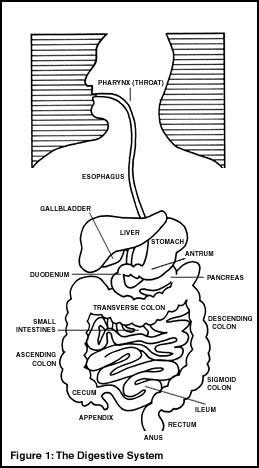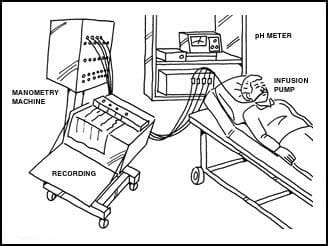What is Antro-Duodenal Manometry?
The term antro-duodenal comes from the two words "antrum" and "duodenum." The antrum is the area at the bottom of the stomach, which prepares food to go into the small intestine. The duodenum is the first part of the small intestine, which receives the food. (Figure 1)
Manometry is the measurement of pressure or contractions in the small intestine. The purpose of antro-duodenal manometry is to determine how well the antrum and the duodenum work together.

Before the Test
- If your child is old enough, explain to your child how the test is done at a time that you feel is best. The nurse will help you with this.
- It may be helpful to bring a favorite toy, video or game to make your child more comfortable during the test.
- Some medications may interfere with this test. You may be asked to stop certain medications up to 72 hours before the test.
- Reassure your child that you will be with him / her during the entire test.
During the Test
- A pediatric anesthesiologist will administer anesthesia, a gas that helps your child sleep during the test.
- During the upper endoscopy (EGD) procedure, the doctor will place a small tube that will be used for this test. The tube may go through the nose and down into the stomach and small intestines. For patients with g-tubes or GJ tubes already in place, it will go through the G tube opening, or stoma. The tube will be secured in place with tape.
- Your child will go to the recovery room (wakeup room).
- Your child will be taken to an inpatient unit where your child will stay for the rest of the testing.
- Your child will need to remain in bed for the remainder of the day and part of the next day.
- Your child must use a bedpan, urinal, or diaper instead of going to the restroom.
- Your child can’t eat or drink anything for the rest of the day and part of the next day. The IV fluids will keep your child hydrated.
- For the rest of the evening, your child will be free to do any activities that can be done in bed. The actual test will begin early the next morning.
- An x-ray will be taken at the bedside the next morning.
- The next morning, the tube will be connected to a portable manometry cart. This tube in turn is connected to the computer. Your doctor reviews this information after the testing is complete.
- Your child will be given a meal and medication as part of the test. Please do not allow your child to eat or drink until instructed to do so by the manometry nurse.
- The test runs for about six hours.

What Will My Child Feel during the Test?
- Your child will have to use a bedpan or urinal.
- This test does not cause pain.
- When the tube is taken out, your child may feel like sneezing or complain of a slight sore throat. These symptoms should go away within a few hours.
After the Test
- When the test is complete, we remove the tape holding the tube in place and then remove the tube. Tape removal may be uncomfortable.
- If your child has a G tube or a GJ tube, it will be replaced when the test is finished.
- Removing the tube is not painful.
- Your child may return to normal diet, play and usual activities.
- The doctor will review results with you in one to two weeks.



